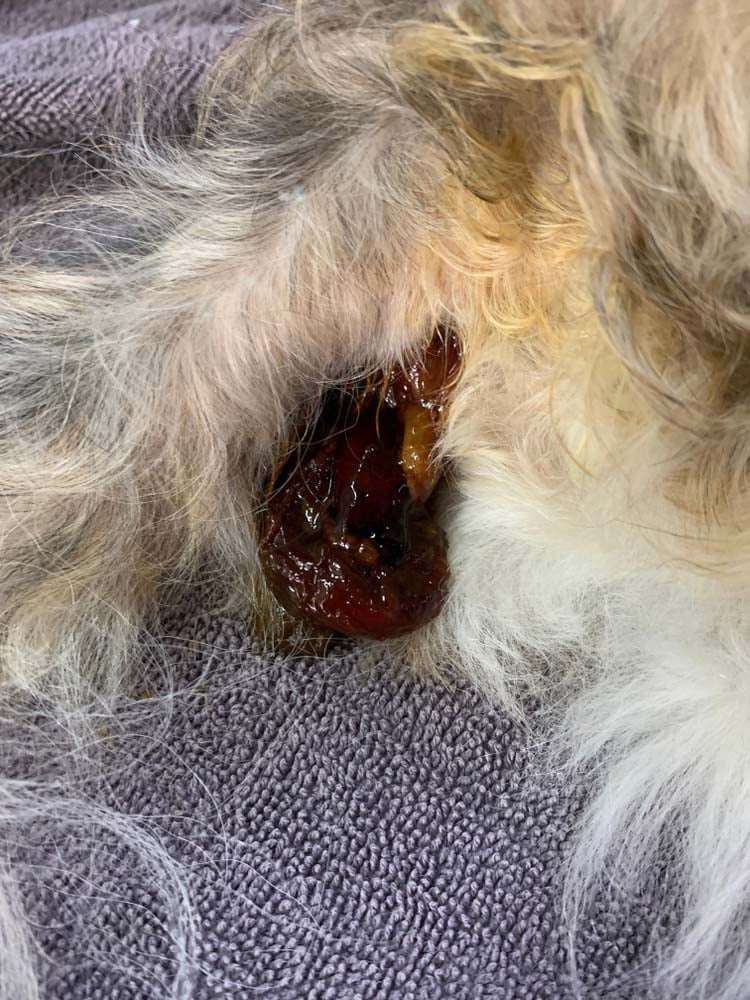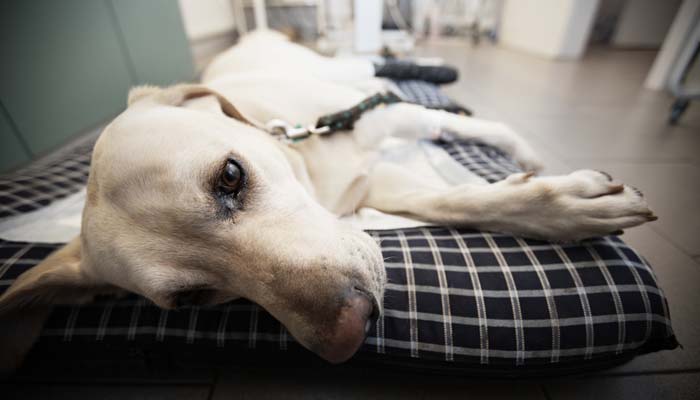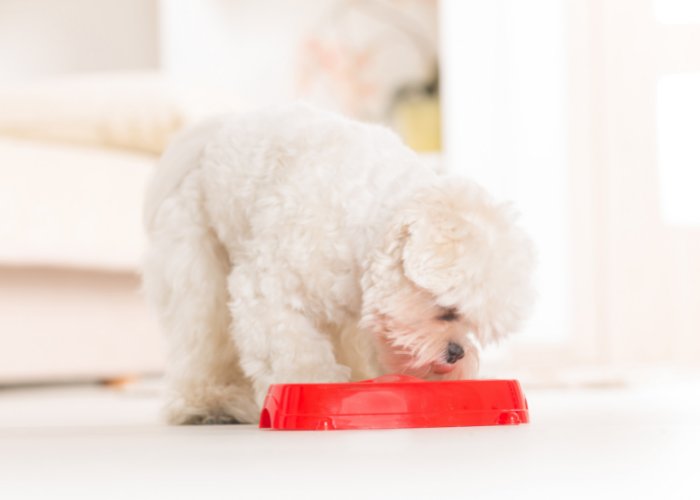Blood in Dog Poop (And What You Can Do About It) – Top Dog Tips
Noticing blood in dog poop can be concerning, especially when your mind suddenly goes to the worst.
Thankfully, blood in your dog’s feces can stem from various causes.
Typical reasons for this problem include food allergies, eating something unsuitable, constipation, colitis, injury, or bacterial or viral infection.
Unfortunately, this symptom could indicate something serious and life-threatening, such as toxicity, blockages, cancer, parvovirus, or hemorrhagic gastroenteritis.
As such, you should always speak to your vet about blood in feces to rule out a serious condition.
Blood in Dog Poop: What To Do
If you’ve noticed blood when your dog has a bowel movement, always contact the vet to rule out anything serious or significant.
It’s always better to have prompt medical care, including necessary treatment.
While a few cases might indicate a severe problem, many mild issues are fully treatable.
Take note of your dog’s poop, whether it’s hard or soft, the color of the blood, and how often you notice it happening.
Any details leading up to the event can help diagnose the issue. Collect a sample of the dog feces to show the vet.
What Does Blood in Poop Look Like?
The blood in your dog’s feces can vary significantly, depending on where the issue is within the digestive tract.
The physical appearance of the dog’s bloody feces can indicate what’s causing the problem, so always tell the vet what it looks like.
Blood that looks bright red and fresh is typically due to bleeding within the lower digestive tract.
Dark, black, or tar-like blood suggests bleeding from the upper digestive tract.
You may occasionally notice blood dripping from the anus as they have a bowel movement.
Related: Black Dog Poop: What Does It Mean?
What If the Dog is Vomiting and Pooping Blood?
A dog vomiting and passing blood simultaneously can suggest hemorrhagic gastroenteritis (HGE).
This condition is potentially life-threatening and occurs when large amounts of fluid seep into the gut.
Your dog can dehydrate quickly with this condition, requiring urgent medical intervention at the earliest signs of problems.
Is Blood in My Dog’s Feces an Emergency?
It depends on the problem. Possible causes always vary significantly, meaning your dog’s situation could be a minor or severe concern requiring medical treatment.
Always speak to your vet as quickly as possible, addressing all symptoms and examining the dog.
Your vet will advise the best course of treatment for its specific ailment.
Should you believe your dog’s condition is life-threatening, contact an emergency vet clinic to have the animal seen.
How Is Blood in my Dog’s Stool Treated?
The vet will offer the best course of treatment available, depending on the dog’s condition.
Possible treatment options include an elimination diet, changing the diet, medication, parasite treatment, fluids for dehydration, surgery, and plenty of other options.
Your vet will better understand treatment after they’ve diagnosed the ailment.
Can Dog Food Cause Bloody Diarrhea?
If your dog has a sensitive stomach, the food can cause an upset stomach.
This scenario is most common when switching the pup’s food from puppy formula to adult dog food.
Knowing this information, gradually introducing new food is always best.
The bloody stool can also stem from eating other toxic human foods the dog finds tasty.
If you believe the blood in the stool is from eating something, let the vet know, as it can help diagnose and treat the issue.
Can a Dog Poop Blood from Stress?
Stress can cause issues like colitis in dogs which can cause blood to appear in the poo.
Stress colitis triggers by environmental changes (moving homes or boarding facilities) and also stems from anxiety-inducing situations like fireworks or thunderstorms.
Other specific problems can trigger colitis in dogs too.
These symptoms will typically resolve within a few days, but owners should still speak with a vet to confirm the cause of the bleeding before leaving it.
Blood Found in Puppy Stool
Contact your vet immediately if you find blood in a puppy’s stool.
Puppies are particularly vulnerable as their immune systems are less developed, putting them at risk of infections and environmental problems.
If you notice blood in a puppy’s stool and the animal is under two weeks old, contact the nearest vet and immediately take them to the clinic.
Are There Home Remedies for Dogs with Bloody Diarrhea?
It is never a good idea to treat your dog’s bloody poo without speaking with your veterinarian first.
Even if your dog is acting normal, it might require urgent treatment.
Although the vet may indicate the problem is nothing to worry about, it’s always best to avoid additional risks.
How to Tell a Dog Has Constipation?
Constipation in dogs is when a dog is struggling to defecate or cannot empty its bowels.
Typically, the stool is hard and dry. Occasionally, liquid or mucus may come from the anus as they try to defecate.
Older or senior dogs are more prone to constipation, but it can impact dogs of any age or breed.
What Should I Do if My Dog Can’t Poop?
Never ignore constipation in dogs. If it’s been more than 24 hours, take your dog to get checked by the vet.
Left untreated, this issue can lead to more severe problems.
The most common cause of constipation in dogs is swallowing foreign objects.
These objects, including hair, grass, and bones, are not easily digestible.
Other causes include blocked anal glands, intestinal problems, lack of fiber, and hernias.
What Should I Do if My Dog Eats Something It Shouldn’t?
Although it’s tempting to offer our leftovers to dogs, plenty of foods can upset a dog’s intestinal tract.
Foods can act like poison to the animal and leave them with severe stomach upset and other more serious problems.
Symptoms include restlessness, vomiting, diarrhea, seizures, and hyperactivity.
Contact your vet for further assessment if you notice any of these unusual symptoms.
What Happens if My Dog Eats a Foreign Body?
Most dogs occasionally eat something they shouldn’t, including chicken bones, balls, socks, or stones.
A few objects might be small enough to pass through the system without causing significant issues, while others could get stuck.
Unfortunately, if these items become stuck in the digestive tract, your dog could become seriously ill quickly.
Your dog may require treatment if your dog eats a foreign body, so contact your vet’s office as soon as possible.
The foreign object can cause physical obstruction due to its shape and size, typically at the outflow of the stomach.
If your dog chews the item, the sharp edges of bones or plastics can pierce the intestine, causing an infection in the abdomen.
Cloth items like thread, pants, socks, or needles can obstruct if they ball up or unravel.
What are Toxic Foreign Bodies?
Occasionally, foreign bodies are potentially toxic material to dogs.
Examples include any items made of zinc or lead, which causes profound systemic disease.
Left untreated, the toxic foreign body can be fatal for the pup.
Treating a Foreign Body
Your vet will evaluate your dog by performing a complete physical examination.
They’ll likely ask you questions to get as much information about your dog as possible.
If you know what the dog has swallowed, give this information to the vet immediately.
Your dog may need blood tests, x-rays, and ultrasounds to evaluate the severity of the obstruction. Additionally, the dog may require surgery to remove the item.
What is Parvovirus and How Does it Affect Blood in Dog Poop?
Parvovirus is a virus that is highly contagious and spreads through direct contact with infected dogs or by indirect contact with contaminated objects.
The puppy is exposed to parvovirus whenever it sniffs, licks, or consumes infected feces.
Puppies between the age of six weeks and six months are most susceptible to parvo.
The severity of the virus varies, depending on the immune system. Puppies and dogs with parvo shed the virus for ten days after clinical recovery.
This virus can survive one month indoors and many months to years outside.
Symptoms of Parvo in Puppies
A puppy with parvo is very sick. The sooner you catch the virus, the sooner your puppy can get to the vet.
Call your vet any time your dog is feeling under the weather, but especially when you notice the following symptoms:
- Vomiting
- Bloody diarrhea
- Lethargy
- Fever
- Weight loss or loss of appetite
- Dehydration
- Depression
What is Colitis in Dogs and How Does it Affect Blood in Dog Poop?
Colitis is a condition where the colon becomes inflamed.
This issue causes several problems, including bloody diarrhea, discomfort, pain, and difficulty defecating.
While you or someone you know may have colitis, humans aren’t the only ones suffering from this painful condition.
It occurs within the animal kingdom as well, including dogs.
Colitis starts with many factors, with one of the common causes being stress.
Although stress isn’t a direct cause, it can add pressure to the dog’s immune system, which makes your dog more susceptible to colitis.
Other causes of colitis include:
- Food allergies
- Intestinal worms
- Irritable bowel syndrome
- Algae or fungal infections
- Injury or damage
- Gastro-intestinal infections
- Eating things not intended for dogs
A vet diagnoses colitis after completing a comprehensive evaluation.
Bring your dog’s most recent stool sample for the vet to evaluate.
The veterinarian may order X-rays or a biopsy if needed. Treatment will typically start by withholding food.
After two days, you can begin to re-introduce high-fiber food.
How to Identify Pancreatitis in Dogs?
Pancreatitis in dogs is a potentially life-threatening condition.
It is critical to know the signs to watch for, including the various causes and risk factors that can bring it on.
Unless an owner knows the symptoms and warning signs before it strikes, pancreatitis can often remain undiagnosed or mistaken for something less serious.
Quite simply, pancreatitis is inflammation of the pancreas.
As this condition is dangerous, anyone suspecting their animal has a case of pancreatitis needs an early assessment.
This is not a condition to treat with at-home methods or do-it-yourself treatment. Always visit a veterinarian as fast as possible.
Symptoms of Pancreatitis:
Although individual symptoms may vary, knowing what to look for can help protect your dog from long-term implications.
If your dog exhibits one of these signs, monitor your dog closely.
Call the vet immediately if your dog shows more than one sign repeatedly.
Why Perform a Stool Sample?
Your vet will likely run a stool sample to check for parasites, as approximately 34% of dogs currently have a parasite in America.
Vets check stool samples for intestinal parasites like whipworms, coccidia, giardia, hookworms, and roundworms.
These intestinal parasites transmit to humans, making it essential to keep your family safe.
How to Collect a Stool Sample for the Vet?
When collecting a stool sample for the vet, try not to overthink it. Make sure you get a container ready.
Always pick up the fresh poop without touching it directly.
For example, use a poop bag as a glove to pick it up. Store the poop in a cool place, like a refrigerator, until the appointment.
As always, write your dog’s name on the same to prevent cross-contamination.
How Much Stool is Needed for Testing?
Most often, owners will collect the entire bowel movement for the vet’s appointment.
This amount is often too much and not needed.
Your vet will only need a small amount of fecal matter to test it.
On average, a vet will only need the size of a sugar cube to complete all testing.
Blood in Dog Poop: Conclusion
Although finding blood in your dog’s poop is scary, it isn’t always as catastrophic as it seems. Basic infections, allergies, and colitis can cause bleeding.
It’s better to treat the illness or problem than to have potentially dire consequences that were easily preventable early on.
The most important thing to do after finding blood in the dog’s stool is to contact your vet and have the animal assessed by a professional.
By monitoring your dog’s bowel movements and contacting the vet at the first sign of problems, your dog will return to its happy self in no time.
READ NEXT: Dog Poop Color Chart: What It All Means
Related












